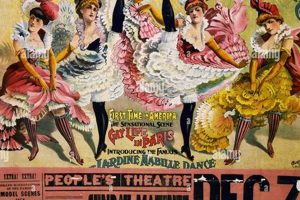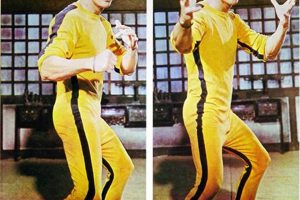These relics are characterized by their vibrant, fluorescent colors that react dramatically under ultraviolet light, commonly known as a blacklight. Typically printed on felt or cardboard, these visually striking decorations emerged in the late 1960s and 1970s, featuring psychedelic imagery, fantasy landscapes, and popular culture icons of the era.
These artifacts represent a significant facet of pop culture history, reflecting the counter-cultural movements and artistic experimentation of the period. Their unique aesthetic qualities and association with a specific time make them highly desirable among collectors. Furthermore, they serve as tangible representations of the artistic and technological advancements of the time, specifically the development and accessibility of fluorescent inks.
The following sections will delve into the factors influencing their value, preservation techniques, and notable artists associated with their creation.
Acquiring and maintaining these collectables demands meticulous attention to detail. These recommendations are provided to assist prospective buyers and current owners in making informed decisions regarding the selection, preservation, and authentication.
Tip 1: Authenticity Verification: Scrutinize the printing method. Original pieces typically employed screen-printing, resulting in a thicker ink application and sharper details when compared to later reproductions. Examine for inconsistencies or signs of digital printing which may indicate inauthenticity.
Tip 2: Condition Assessment: Evaluate the substrate material for signs of damage. Tears, fading, and staining significantly reduce value. Prioritize examples exhibiting minimal degradation, reflecting careful storage and handling.
Tip 3: Subject Matter and Rarity: Certain themes or artists are more coveted. Examples showcasing iconic imagery, influential figures, or limited-edition prints command higher valuations in the collector’s market.
Tip 4: Ultraviolet Light Inspection: Employ a blacklight to analyze the reactivity of the inks. Genuine examples exhibit a characteristic bright fluorescence, indicative of the specific pigments used during the period of production. Variations in intensity or hue may suggest restoration or reproduction.
Tip 5: Storage Protocols: Protect these pieces from direct sunlight and excessive humidity. Ideally, store them flat, interleaved with acid-free paper, within a climate-controlled environment to mitigate deterioration.
Tip 6: Professional Consultation: When in doubt, seek guidance from experienced appraisers or specialists. Their expertise can provide invaluable insights into the value, authenticity, and historical context of a particular piece.
Tip 7: Documentation and Provenance: Whenever possible, obtain documentation related to its origin, ownership history, or exhibition record. Provenance adds significant value and enhances the collectability of the item.
Prioritizing authenticity verification, condition assessment, and proper preservation techniques allows one to appreciate and maintain the value and unique historical value of vintage fluorescent artwork.
The subsequent sections will discuss the market trends and key figures in the genre.
1. Visual Aesthetics
The visual aesthetics of these specimens are inextricably linked to their cultural impact and collectibility. The deliberate application of design principles, combined with the unique properties of fluorescent inks, resulted in artifacts that captivated audiences and reflected the spirit of the era.
- Psychedelic Imagery
Many showcase swirling patterns, distorted perspectives, and fantastical scenes. This design choice mirrored the experimentation with altered states of consciousness prevalent during the 1960s and 70s. Examples include depictions of swirling galaxies, melting faces, and surreal landscapes intended to evoke a sense of wonder and introspection.
- Vibrant Color Palettes
The selection of highly saturated fluorescent colors is a defining characteristic. These hues, often juxtaposed in unexpected combinations, created a visually stimulating experience, especially under blacklight illumination. The use of vivid pinks, greens, yellows, and oranges heightened the impact of the imagery and contributed to the overall psychedelic effect.
- Pop Culture Iconography
Popular figures from music, film, and art were frequently incorporated into these designs. Images of rock stars, movie characters, and iconic symbols provided a connection to the broader cultural landscape of the time. The integration of familiar imagery with psychedelic aesthetics created a unique fusion of the mainstream and the counterculture.
- Symbolic Representation
Many posters employed symbolic imagery to convey messages related to peace, love, and social change. Doves, flowers, and other symbols were used to promote ideals and express dissent against prevailing social norms. The use of symbolism added depth to the artwork and provided a visual language for communicating complex ideas.
These aesthetic elements worked in concert to create objects that are more than mere decorations. They are artifacts reflecting the sensibilities and values of a transformative period in history, thus the aesthetic consideration remains significant to this day.
2. Fluorescent Pigments
Fluorescent pigments are indispensable to the unique visual properties that define these artifacts. The very existence of “vintage blacklight posters” as a distinct art form hinges on the availability and application of these specialized compounds. The posters’ characteristic glow under ultraviolet (UV) light is a direct result of the fluorescent pigments absorbing UV radiation and re-emitting it as visible light. Without these pigments, the posters would be mere images on paper, lacking the vibrant, eye-catching quality for which they are known. A practical example is the use of zinc sulfide-based pigments, commonly found in many of these pieces. These pigments react strongly to UV light, producing a bright, greenish-yellow glow that is instantly recognizable. The understanding of these pigment properties is vital in assessing the authenticity and condition of these vintage relics.
The incorporation of fluorescent pigments enabled artists to explore a new dimension of visual expression. The vivid, otherworldly colors created a striking contrast with traditional printing methods, allowing for the creation of imagery that resonated with the counterculture movement. The pigments allowed for visual representations of internal states, dreamscapes, and abstract concepts, all amplified by the blacklight illumination. Furthermore, the choice of specific pigments, and their combinations, influenced the overall aesthetic and market value of the artwork. Posters featuring rare or particularly vibrant pigments often command higher prices among collectors.
In summary, the application of fluorescent pigments was a crucial catalyst in the emergence and enduring popularity of “vintage blacklight posters”. The understanding of these materials, their properties, and their impact on the artwork is essential for appreciating, preserving, and authenticating these tangible representations of a transformative era. The degradation of these pigments over time presents an ongoing challenge for conservation efforts, highlighting the need for further research into optimal preservation strategies. The pigments’ selection and use is a core facet of appraising these visual artifacts.
3. Counterculture Movement
The counterculture movement of the 1960s and 1970s provided the fertile ground from which vintage blacklight posters emerged as a significant art form and cultural artifact. These posters acted as a visual manifestation of the movement’s core tenets, reflecting its rebellion against societal norms, exploration of alternative realities, and embrace of psychedelic experiences.
- Visual Representation of Psychedelic Experiences
The counterculture embraced the use of psychedelic substances to expand consciousness and challenge conventional perceptions. Blacklight posters, with their vibrant, hallucinatory imagery and glowing colors under ultraviolet light, served as visual representations of these experiences. They provided a tangible way for individuals to share and celebrate their altered states of consciousness.
- Rejection of Mainstream Aesthetics
The movement actively rejected the established artistic and design conventions of the time. Blacklight posters, with their unconventional color palettes, surreal imagery, and deliberately “unprofessional” aesthetic, stood in stark contrast to the clean lines and muted tones that dominated mainstream visual culture. This rejection of traditional aesthetics was a deliberate statement of defiance and a celebration of alternative forms of expression.
- Dissemination of Countercultural Ideals
These posters became a means of spreading countercultural messages and promoting alternative lifestyles. They often featured imagery and slogans related to peace, love, environmentalism, and social justice. Displayed in homes, dorm rooms, and gathering places, they served as visual reminders of the movement’s values and a way to connect with like-minded individuals.
- Affordable and Accessible Art Form
Unlike traditional art forms, blacklight posters were relatively inexpensive to produce and widely accessible to the general public. This affordability made them a democratic art form, allowing individuals from all socioeconomic backgrounds to participate in the countercultural movement and express their individuality. They were readily available in head shops, record stores, and alternative bookstores, further contributing to their widespread popularity.
The visual statements made by the “vintage blacklight posters” became synonymous with the movement’s ethos, and those artifacts are now representative of that transformative time.
4. Preservation Techniques
The long-term survival of vintage blacklight posters is intrinsically linked to the application of appropriate preservation techniques. These techniques aim to mitigate the detrimental effects of environmental factors and inherent material degradation, ensuring the continued visibility of the posters’ unique aesthetic qualities and historical significance. Improper storage or handling invariably leads to irreversible damage, diminishing both the visual appeal and the monetary value of these artifacts. For instance, prolonged exposure to ultraviolet radiation, ironically, causes fading of the fluorescent pigments, effectively negating the intended visual effect. Similarly, fluctuations in humidity levels promote the growth of mold and mildew, particularly on felt-backed posters, leading to structural damage and discoloration.
Effective preservation strategies encompass several key elements. Controlled environmental conditions, specifically stable temperature and humidity levels, are paramount. Ideally, posters should be stored flat in acid-free enclosures, away from direct sunlight and sources of heat. Archival-quality materials, such as acid-free paper and buffered mounting boards, provide a protective barrier against chemical migration from surrounding materials. Regular inspections for signs of deterioration are also essential, enabling early intervention to prevent further damage. In cases of significant damage, professional conservation treatments, such as cleaning, consolidation, and repair, may be necessary to stabilize the artwork. However, such treatments should only be undertaken by qualified conservators with expertise in handling delicate materials and fluorescent pigments.
In conclusion, the successful preservation of vintage blacklight posters requires a proactive and informed approach. The careful application of appropriate preservation techniques is critical for mitigating the effects of aging and environmental degradation, ensuring that these relics of the counterculture movement continue to be appreciated and studied for generations to come. The degradation of materials and the complexity of fluorescent pigments necessitate a comprehensive conservation strategy. Without these targeted preservation efforts, this unique art form risks fading into obscurity, losing its vibrancy and historical relevance.
5. Market Valuation
The valuation of vintage blacklight posters is a complex process influenced by several interacting factors. These relics, once inexpensive counterculture adornments, have transformed into sought-after collectibles, commanding prices that vary widely based on condition, rarity, and cultural significance. Understanding the dynamics influencing market valuation is essential for collectors, dealers, and enthusiasts alike.
- Condition Assessment
The physical state of a poster exerts a primary influence on its market value. Examples exhibiting minimal damage, such as tears, fading, or staining, command a premium. Preservation history, including storage conditions and prior restoration attempts, is also scrutinized. A poster in pristine condition, exhibiting vibrant colors and structural integrity, will invariably be valued higher than a comparable example marred by significant degradation.
- Rarity and Subject Matter
Scarcity significantly elevates the value of specific posters. Limited-edition prints, promotional items, or posters featuring particularly iconic or controversial imagery are highly desirable. The subject matter itself plays a role; posters depicting popular musicians, films, or cultural events from the 1960s and 70s often garner increased attention from collectors, driven by nostalgia and historical interest.
- Artist Recognition and Provenance
Posters created by known artists or designers often command higher prices than those of unknown origin. The artist’s reputation, body of work, and historical significance contribute to the perceived value of the piece. Provenance, or the documented history of ownership, can also enhance value, particularly if the poster can be traced back to its original production or a notable collection.
- Authenticity Verification
The proliferation of reproductions and fakes necessitates careful authenticity verification. Original posters typically exhibit specific printing characteristics, such as the type of ink used, the texture of the paper or felt, and the presence of specific markings or signatures. Expert appraisal and authentication services are often employed to determine the genuineness of a poster, ensuring its value in the collector’s market.
These facets are intertwined, collectively shaping the market value of these artifacts. Condition, rarity, artist recognition, and verified authenticity serve as the primary determinants of a blacklight poster’s worth in the collector’s market. Successfully navigating this complex landscape requires diligence, knowledge, and a discerning eye.
Frequently Asked Questions
This section addresses common inquiries regarding the identification, valuation, and preservation of vintage blacklight posters. The information is intended to provide clarity and guidance to collectors and enthusiasts.
Question 1: What defines a “vintage” blacklight poster?
A vintage blacklight poster is generally considered to be one produced during the late 1960s and 1970s. Production techniques, materials, and subject matter are typical for this period.
Question 2: How can one distinguish an original from a reproduction?
Original posters often exhibit screen-printed ink with a thicker texture. Paper and felt composition differ from modern materials. Examination under ultraviolet light can reveal subtle differences in pigment fluorescence.
Question 3: What factors contribute to the value of a particular item?
Value is determined by condition, rarity, artist notoriety, subject matter, and documented provenance. Posters in pristine condition featuring iconic imagery by known artists command higher valuations.
Question 4: What are the primary causes of deterioration?
Exposure to ultraviolet light, humidity fluctuations, and improper handling are the primary causes. Prolonged exposure leads to fading, while humidity promotes mold growth.
Question 5: What are recommended preservation methods?
Storage in a cool, dry environment, away from direct sunlight, is crucial. Acid-free materials should be used for mounting and storage. Avoid folding or creasing.
Question 6: Where can one seek professional appraisal services?
Appraisal services are available through reputable auction houses, art galleries specializing in vintage posters, and independent appraisers with expertise in pop culture memorabilia.
In summation, the identification, valuation, and preservation of these relics demands careful assessment and adherence to established best practices.
The next section will explore specific artists and their contributions to the genre.
Concluding Remarks on Vintage Blacklight Posters
This exploration has illuminated the multifaceted nature of these artifacts, from their vibrant aesthetic qualities to their cultural significance within the counterculture movement. The analysis encompassed considerations regarding authenticity, preservation, and market valuation, highlighting the importance of informed decision-making for collectors and enthusiasts.
The enduring appeal of vintage blacklight posters lies not only in their visual impact but also in their ability to evoke a sense of nostalgia and connection to a transformative era. Continued efforts in preservation and scholarly research are essential to ensure the legacy of this unique art form for future generations.







